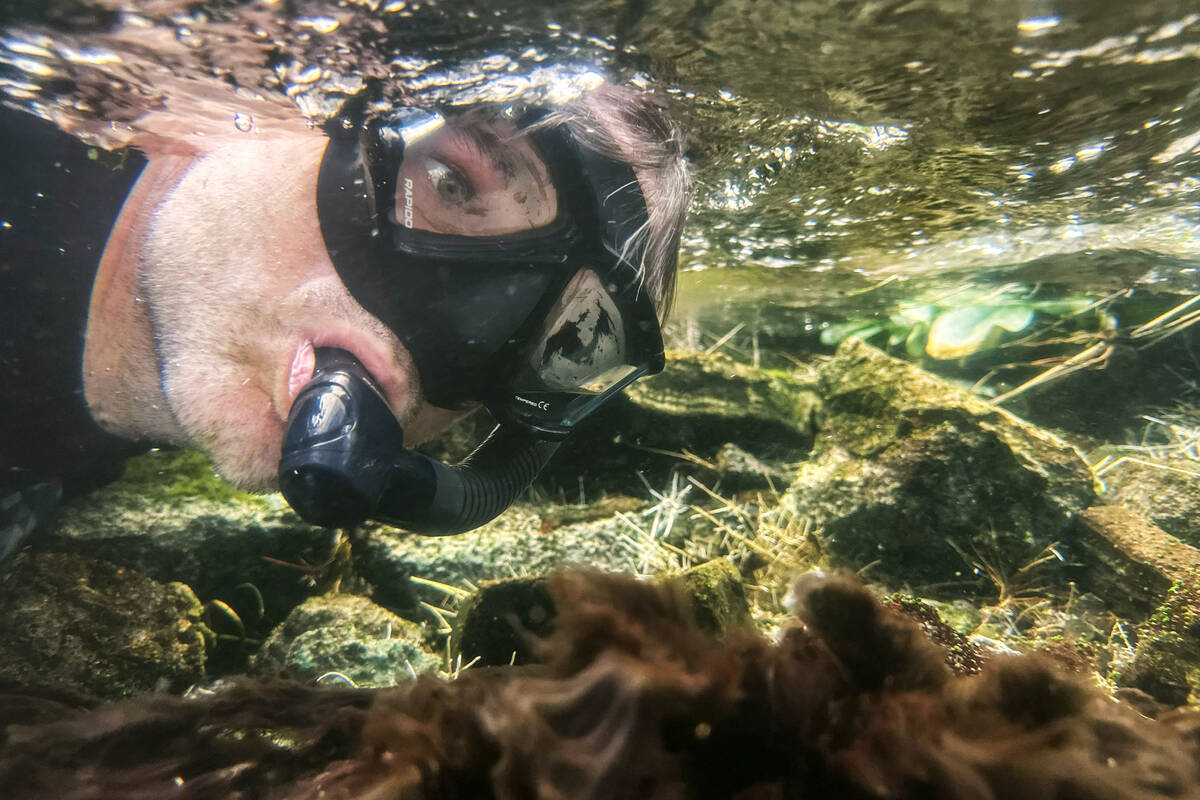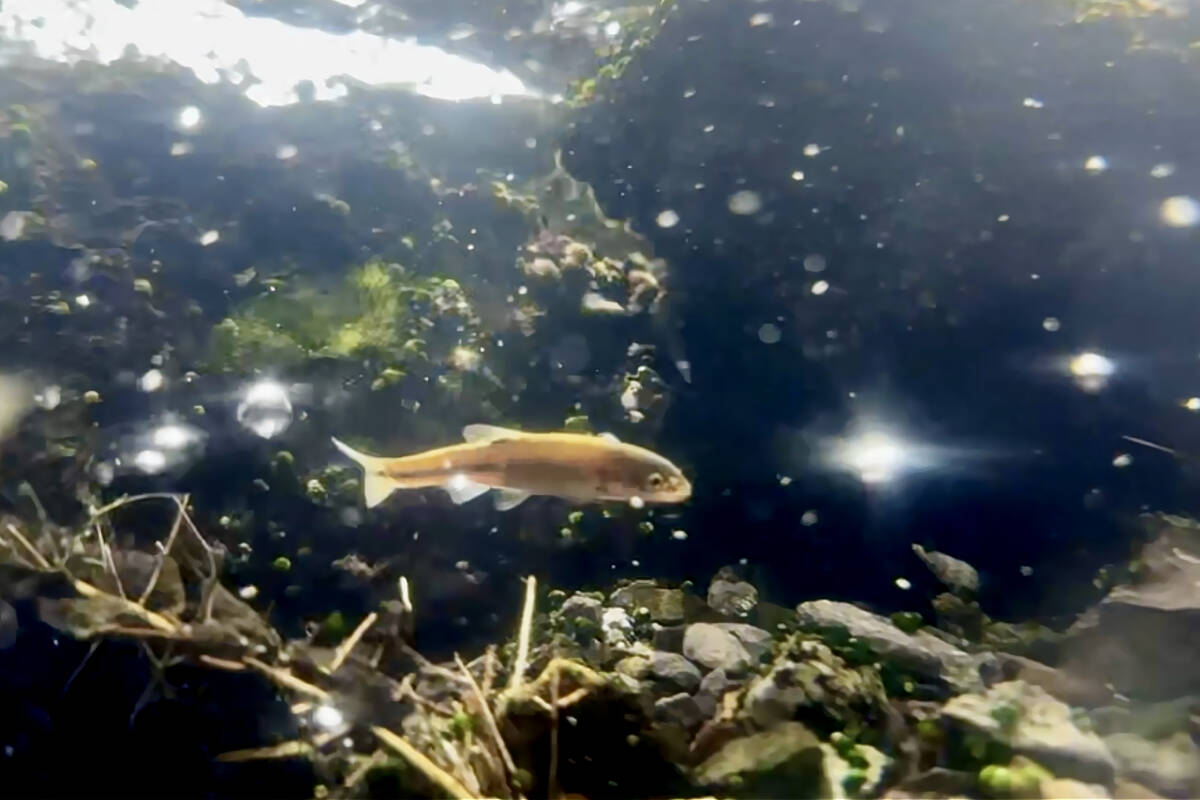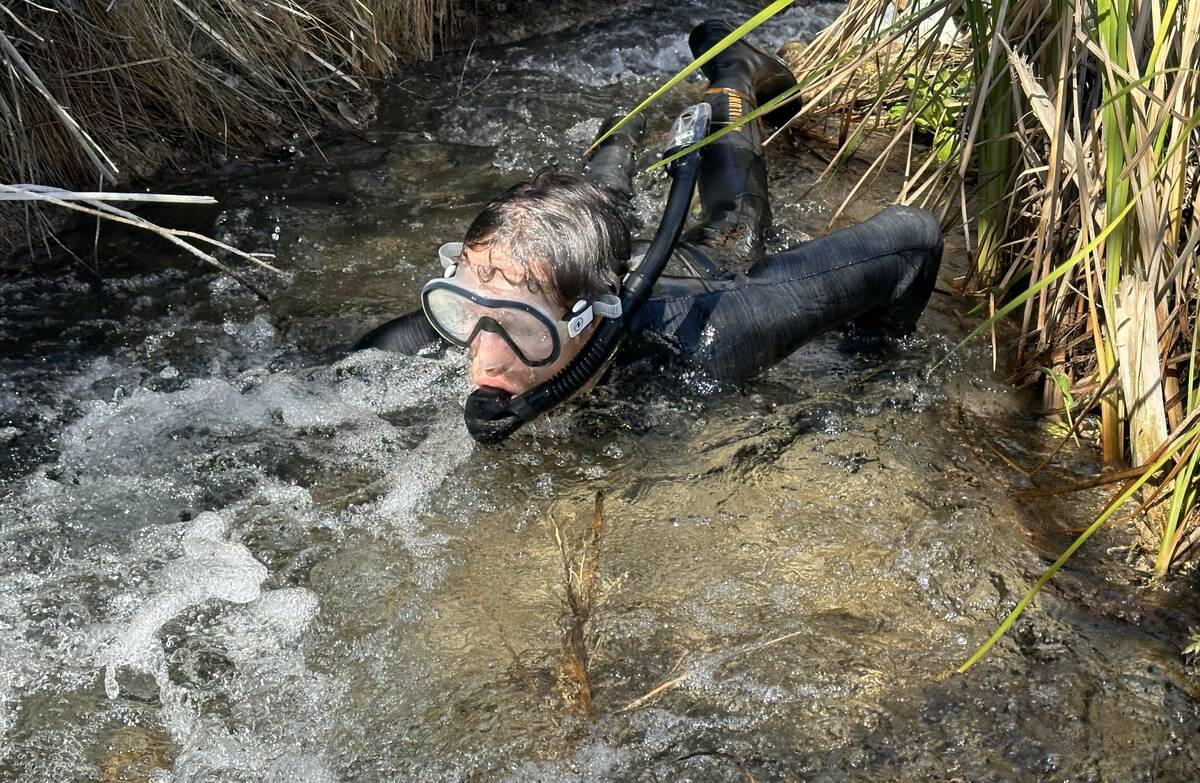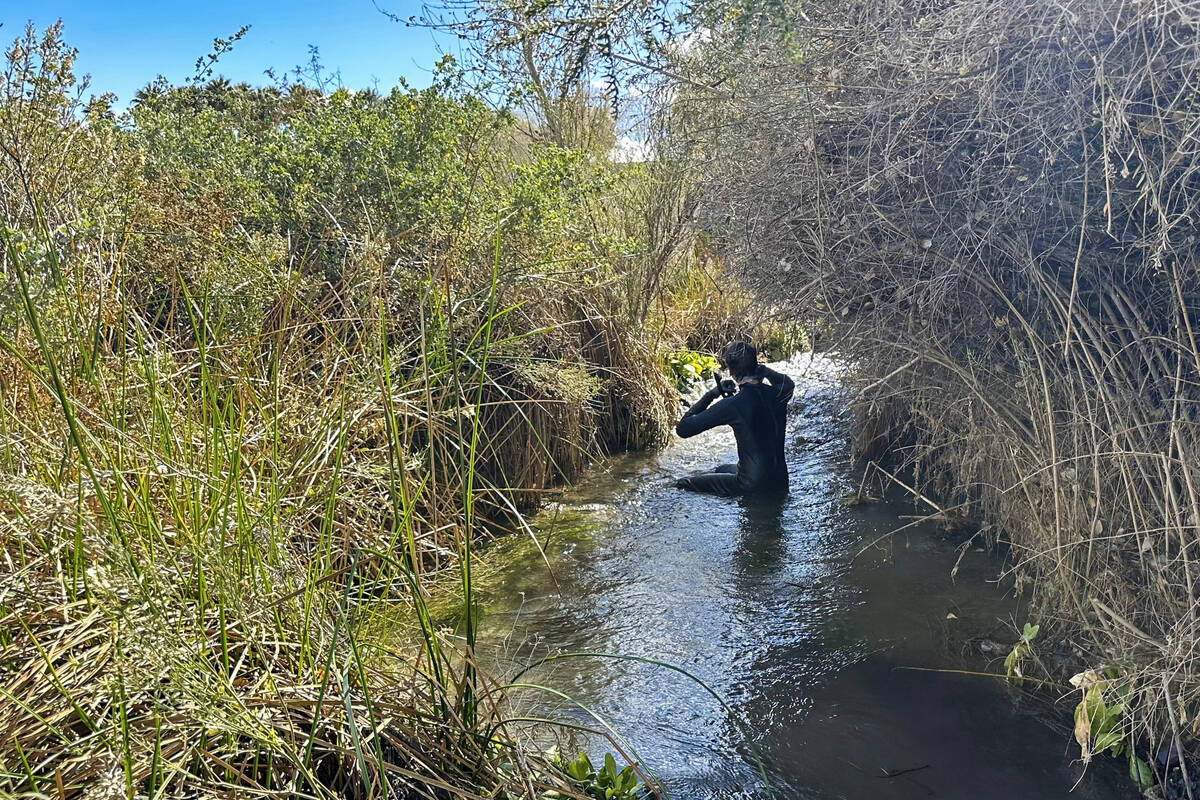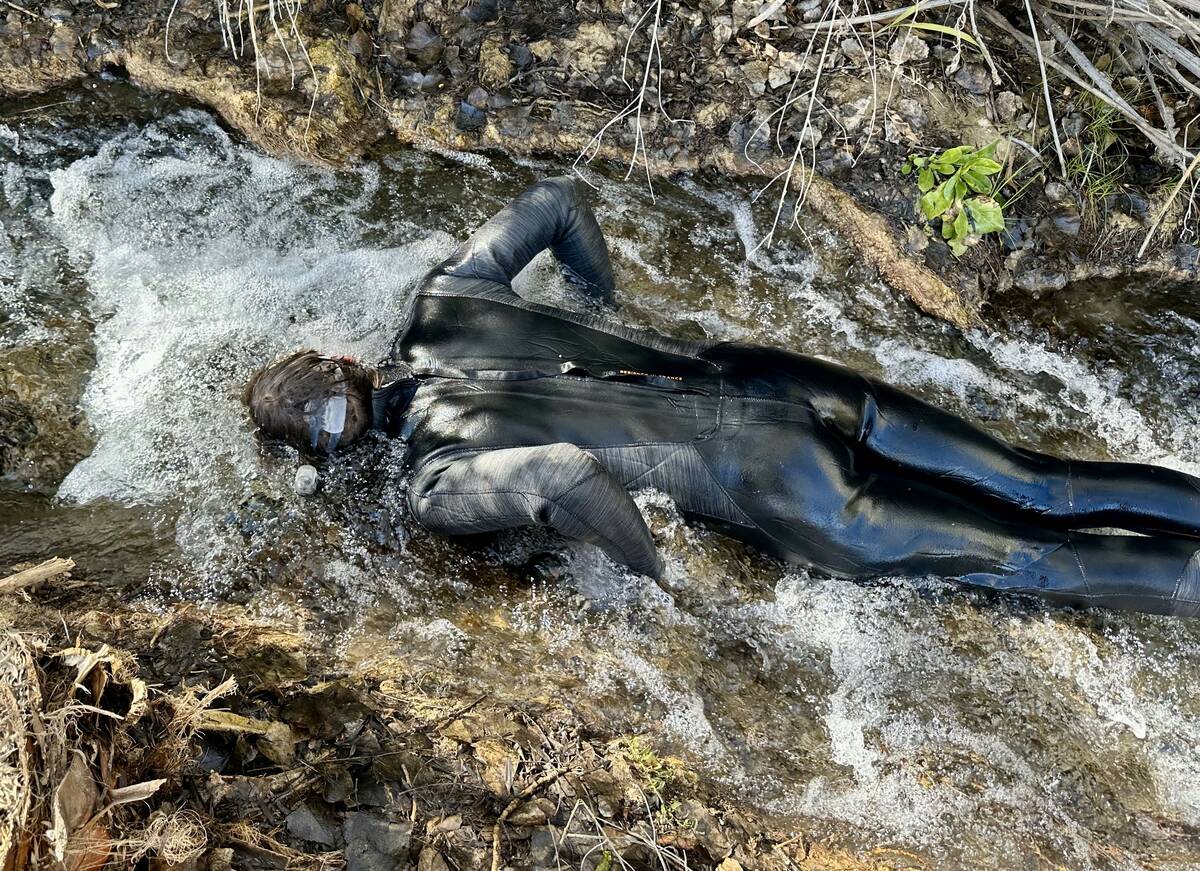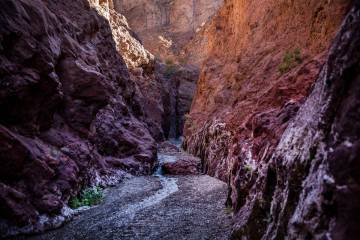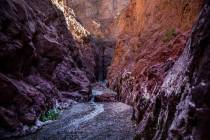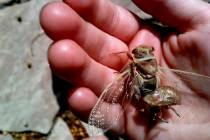‘This species occurs only here’: Snorkeling scientists count endangered fish
Kevin Guadalupe walked along the banks of the stream as Montana Stevens, outfitted in snorkel gear, popped his head out of the water to report how many fish he’d seen.
“Two adults, two juveniles,” said Stevens, a biologist with the U.S. Fish and Wildlife Service.
Guadalupe, a Nevada Department of Wildlife biologist, wrote the numbers on a pad.
Both were among the group of surveyors from several different agencies who recently snorkeled while inching forward in essentially a flat crawl in the warm, shallow streams and springs that comprise the headwaters of the Muddy River, about 60 miles northeast of Las Vegas near Moapa.
“This water is awesome,” Guadalupe said. “It’s kind of like snorkeling Hawaii. It’s crystal clear, warm.”
The count showed that the population of the fish, which only exists in these waters — about 6 miles worth of streams and springs in the Southern Nevada desert — appears to be stable and similar to the numbers over the past few years.
‘They’re kind of drifting’
Being in the water means seeing the approximately 4-inch, torpedo-shaped, olive-colored Moapa dace living its life, Guadalupe said.
“They’re kind of drifting, they don’t really care,” he said. “You’re just watching them do their natural stuff.”
If he sees one, or more, with the telltale black dots on their tails, he counts them, gets up and lets the data-taker who is accompanying him along the banks know how many he’s seen. Just like Stevens and the other snorkeling surveyors would do.
Adrienne Reschman, a biology intern with the Southern Nevada Water Authority, was taking numbers from Tim Ricks, an environmental biologist from the water authority who was also snorkeling and counting.
This year’s annual winter count — a count also happens every summer, in August — took place Feb. 20 and 21. It involved about 16 people from multiple agencies.
Over the two-day count, they tallied 1,935 Moapa dace.
That’s a “remarkably similar” number to the previous two February counts in 2023, when 1,933 were tallied, and in 2022, when 1,956 were counted, David Syzdek, environmental biologist with the Southern Nevada Water Authority, said in an email.
Syzdek, who has been involved in the count for 17 years, said he was pleased that the numbers are holding steady.
Counting fish ‘one by one’
The Moapa dace’s habitat is found entirely within the 116-acre Moapa Valley National Wildlife Refuge, some adjacent private land and the 1,250-acre Warm Springs Natural Area, which the water authority bought for $69 million in 2007.
“This species occurs only here,” said Michael Schwemm, a senior fish biologist with the U.S. Fish and Wildlife Service.
He said the “crystal clear” waters, with bathwaterlike temperatures of about 90 degrees, makes for an “ideal system to do ocular estimates,” or counting by eye.
“A lot of times, populations are counted by trapping and population estimates and statistical methods, but here, we actually count fish one by one,” Schwemm said.
Also known as Moapa coriacea, the Moapa dace has been listed on the federal endangered species list since the first such list in 1967, Syzdek said.
Threats to Moapa dace
The main threats to the species include water withdrawals, which Syzdek explained could include anything from groundwater pumping and/or irrigation diversions for farming or ranching, invasive species that might prey on the fish or compete for food with them, nonnative plants and poorly designed man-made parts of a water system including culverts.
Syzdek said when the water authority acquired the area, the number of dace had consistently been about 1,000.
But in 2007, the numbers dropped from 1,172 to 459, with scientists not exactly sure why.
The fish appear to be survivors. After a count in 1994 tallied 3,825 Moapa dace, a fire that summer took out about half the population, according to Las Vegas Review-Journal archives.
They also seemed to have emerged unscathed after a July 1, 2010, wildfire in the area.
And ridding the Muddy River of the invasive blue tilapia, which was blamed for pushing the Moapa dace to the edge of extinction, also helped.
Since that precipitous drop into the 400s, Syzdek said, the numbers have climbed up closer to 2,000.
“Our goal for delisting the species and its removal from the endangered species list would be 6,000 Moapa dace, so we’ve got a ways to go before we get to 6,000,” Syzdek said.
Promising signs
At the count, Syzdek said it was encouraging to see the amount of reproduction happening.
In total, he said, the February 20 and 21 count tallied 1490 adults, 314 juveniles and 130 larvae.
“It’s really good — we’ve been seeing lots of juveniles and lots of larval fish, so it’s exciting,” Syzdek said. “Hopefully we’ll see the increase in adults next year.”
Efforts to boost the fish’s numbers have also received some recent help.
In June 2023, 18 captively bred and raised Moapa dace were released into the wild at the Moapa Valley National Wildlife Refuge.
In November 2023, the Department of the Interior said the water authority was granted $743,329 to support improvements to the Muddy River at the Warm Springs Natural Area.
Guadalupe said the big question, and mystery, about any endangered species, including the Moapa dace, is what the impact on the ecosystem would be if the species were to disappear.
The fish numbers also serve as an indicator of the overall health of the environment, he said.
“If you start to see those numbers go down, that could tell you something’s out of balance,” Guadalupe said.
Contact Brett Clarkson at bclarkson@reviewjournal.com.



